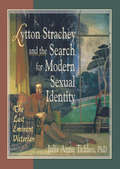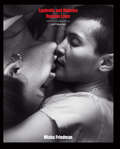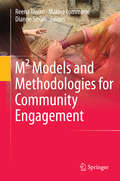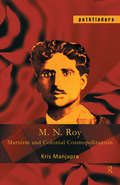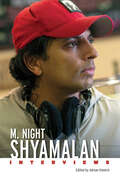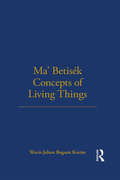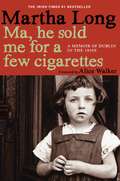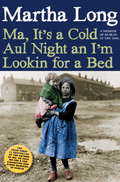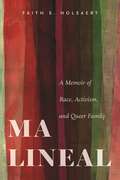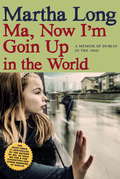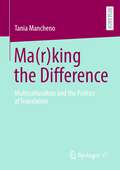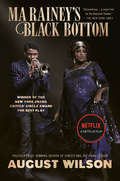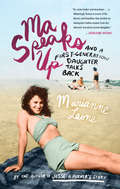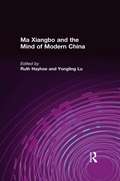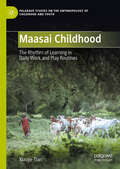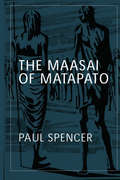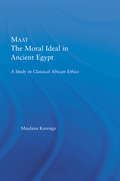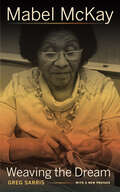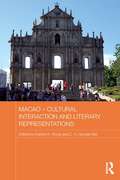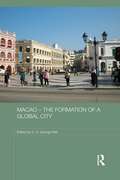- Table View
- List View
Lytton Strachey and the Search for Modern Sexual Identity: The Last Eminent Victorian
by Julie Anne TaddeoExamine Lytton Strachey’s struggle to create a new homosexual identity and voice through his life and work!This study of Lytton Strachey, one of the neglected voices of early twentieth-century England, uses his life and work to re-evaluate early British modernism and the relationship between Strachey’s sexual rebellion and literature.A perfect ancillary textbook for courses in history, literature, and women’s studies, Lytton Strachey and the Search for Modern Sexual Identity: The Last Eminent Victorian contributes to the expanding field of queer studies from an historian’s perspective. It looks at homosexuality through the eyes of Lytton Strachey as opposed to the too-often analyzed Oscar Wilde and E.M. Forster. Questioning the idea that homosexuality is a “transgressive rebellion,” as Strachey as well as scholars on Bloomsbury have insisted, this volume focuses on the ongoing conflict between Strachey’s Victorian notions of class, gender, and race, and his desire to be modern.Linking Strachey’s life and work to the larger movement of English modernism, Lytton Strachey and the Search for Modern Sexual Identity examines: Strachey’s role at Cambridge before World War I how he created his version of homosexuality out of the Victorian tradition of male romantic friendship his relations with the British Empire as he constructed a rich fantasy life that rested on racial and class differences his friendships and rivalries with the women of Bloomsbury how Strachey’s use of sexuality, androgyny, and history defined (and undermined) his brand of modernismThis thoughtfully indexed, well-referenced volume looks at Strachey’s life, in the words of author Julie Anne Taddeo, “to illustrate some of the issues concerning his generation of Cambridge and Bloomsbury colleagues and how they battled the Victorian ideology, often without success.” It is an essential read for everyone interested in this fascinating chapter in literary (and queer) history.
Lyudmila and Natasha: Russian Lives
by Misha FriedmanThe photojournalist Misha Friedman is renowned for his efforts to capture life in contemporary Russia, documenting subjects as varied as political corruption, the dangers of coal mining, the tuberculosis epidemic, and the Bolshoi Ballet. In publications ranging from the New York Times, the Washington Post, Time, and the New Yorker, Friedman’s grimly evocative black-and-white images—“intimate, behind-the-scenes photos” (Time)—have been credited with capturing moments of intense pathos, bleak existence, and human dignity. He has received multiple international awards for his “unflinching” lens and his intrepid reporting.<P><P> For his new collection of photographs, Lyudmila and Natasha, Friedman trains his lens on a gay couple living on Saint Petersburg, offering a series of intimate snapshots of their relationship as it unfolds over the course of a year. Faced with a hostile political climate, financial difficulties, and often unstable living arrangements, the subjects of this stunning book reveal the possibilities for love in the most uncertain of times. With the fabled city of Saint Petersburg as its backdrop, Lyudmila and Natasha powerfully evokes both a vital place and the people who call it home.
The M&F Solution (Third Edition)
by David KnoxTextbook for a course in marriage, family, and other intimate relationships.
M Is for Mystical: A Book for Mini Mystics
by Emma MildonMindfulness is as easy as ABC: make learning the alphabet a portal to learning about the world with bestselling author Emma Mildon&’s illuminating picture book. In a time when mindfulness is becoming mainstream and parents are more aware of the options available to them, they are seeking content to educate and empower their children. This is largely reflected in the huge increase in traffic, demand, and engagement of online content serving holistic parenting insights and new age tips for the new age parent. So, why not make mindfulness as easy as learning your ABCs? An A-Z of spirituality in simple explanations and fun, engaging exercises for kids—yoga, breathwork, oils to help calm or energize, mudras, to crystals—M Is for Mystical offers tools to transform little lives.
M.K. Gandhi, Media, Politics and Society: New Perspectives (Palgrave Studies in the History of the Media)
by Chandrika KaulThis Palgrave Pivot showcases new research on M.K. Gandhi or Mahatma Gandhi, and the press, telegraphs, broadcasting and popular culture. Despite Gandhi being the subject of numerous books over the past century, there are few that put media centre stage. This edited collection explores both Gandhi’s own approach to the press, but also how different advocacy groups and the media, within India and overseas, engaged with Gandhi, his ideology and methodology, to further their own causes. The timeframe of the book extends from the late nineteenth century up to the present, and the case studies draw inspiration from a number of disciplinary approaches.
M² Models and Methodologies for Community Engagement
by Reena Tiwari Marina Lommerse Dianne SmithHow can we engage communities? What is empowerment? To what extent should the project process be participatory? How is an outsider-insider relationship handled? How do researchers negotiate with the hegemony of western cultural interpretations? How are organizational and contextual influences handled in a project? What leadership demands do such projects place on researchers? What is capacity building? What are creative leaders and creative communities? How does the researcher journey from their studio to the situation? M² Models and Methodologies for Community Engagement discusses key theoretical constructs -- community engagement, capacity building, and community empowerment -- in order to demonstrate how theory and practice are relevant to the development of forms of community involvement. The book maps the attributes of community based projects by moving beyond simply bringing people together from a variety of disciplines, and taking an approach which is transdisciplinary and applicable across cultures and genres. Here, all people -- including the community -- are ongoing contributors, and can freely move between their own and others' discipline-specific arenas. M² differs from and extends on other works in this field of practice and research, in that its transdisciplinary, collaborative approach positions the community as a particular kind of discipline to create real change in diverse locations and fields of experience. The book is in itself a model of community engagement, as the researchers have formed a community of research and practice for change, and have developed a transformative model for community engagement that is greater than the sum of its parts - hence M². M² offers a valuable resource for students, researchers, academics, practitioners, policy developers and volunteers from the fields of architecture, interior architecture, health, planning, anthropology, education, home economics, communication, political studies and development studies.
M. N. Roy: Marxism and Colonial Cosmopolitanism (Pathfinders Ser.)
by Kris ManjapraThis is a work of South Asian intellectual history written from a transnational perspective and based on the life and work of M.N. Roy, one of India’s most formidable Marxist intellectuals. Swadeshi revolutionary, co-founder of the Mexican Communist Party, member of the Communist International Presidium, and a major force in the rise of Indian communism, M.N. Roy was a colonial cosmopolitan icon of the interwar years. Exploring the intellectual production of this important thinker, this book traces the historical context of his ideas from 19th-century Bengal to Weimar Germany, through the tumultuous period of world politics in the 1930s and 1940s, and on to post-Independence India. In this book the author makes a number of valuable theoretical contributions. He argues for the importance of conceiving the ‘deterritorial’ zones of thought and action through which Indian anti-colonial political thought operated, and advances a new periodisation for Swadeshi on this basis. He also argues against viewing ‘international communism’ of the 1920s as a single monolith by highlighting the fractures and contestations that influenced colonial politics worldwide.A fresh and insightful perspective on the history of India in the interwar years, this book will be of great interest to scholars and students of the modern history of South and East Asia, America and Europe, and to those interested in anti-colonial struggles, Communist politics and trajectories of Marxist thought in the 20th century.
M. Night Shyamalan: Interviews (Conversations with Filmmakers Series)
by Adrian GmelchAs a visionary and distinctive filmmaker, M. Night Shyamalan (b. 1970) has consistently garnered mixed reception of his work by critics and audiences alike. After the release of The Sixth Sense, one of the most successful films from the turn of the millennium, Shyamalan promptly received two Academy Award nominations for Best Director and Best Original Screenplay. Since then, lauded films such as Unbreakable (2000), Signs (2002), and Split (2016) have alternated with less successful and highly criticized works, such as Lady in the Water (2006), The Last Airbender (2010), and After Earth (2013). Yet despite his polarizing aesthetics and uneven career, for two decades Shyamalan has upheld his cinematic style and remained an influential force in international film. With interviews spanning from 1993 through 2022, M. Night Shyamalan: Interviews is the first survey of conversations with the filmmaker to cover the broad spectrum of his life and career. This collection includes interviews with renowned American film journalists such as Jeff Giles, Carrie Rickey, and Stephen Pizzello, and reflects the intense international interest in Shyamalan’s work by including newly translated conversations from French and German sources. Through its thorough and careful curation, this volume is bound to shake up readers’ perceptions of M. Night Shyamalan.
M4M: For an Hour or Forever--the Gay Man's Guide to Finding Love Online
by Jack MauroAND -- FOR BETTER OR WORSE -- THERE'S NO LAST CALL. Millions of gay men are searching for love. And the vast majority of them are now searching online. But while the Internet helps bring people together, its anonymity, lack of rules, and easy stage for false advertising often result in disappointing matches. But the right guy is out there. Chances are good that every gay man could find exactly what he's looking for online . . . if he only knew where and how to look. In M4M, Jack Mauro offers candid, witty advice on every aspect of the gay online-dating arena -- how to (and how not to) compose a successful profile, what kind of photo to use ("normal," naked, and everything in between), the art of instant messaging (from the basics to advanced seduction), "straight" men in gay chats, navigating the usual suspects found in seemingly every chat room, taking it offline, and much, much more. Whether the goal is a quick fling or a lifelong partnership, M4M gives both the frustrated online veteran and the curious newbie everything they need to know to get them away from the keyboard and into a satisfying real-life connection.
Ma' Betisek Concepts of Living Things: Volume 54
by Wazir-Jahan KarimThe Ma' Betisek are a group of aborigines who live on the mangrove coastal area of Selangor in peninsular Malaysia. Dr Karim's study is mainly focused on the Ma' Betisek communities on Carey Island, off the west coast of Selangor and in particular three villages - Sungei Sialang, Sungei Mata and Sungei Bumbun. Few changes have taken place in the lives of the Betisek people on the island since 1975. On the mainland, the Ma' Betisek are busy keeping pace with development and modem life. However, despite increasing deforestation and new urban influences on the island, the Carey Island communities continue to preserve their naturistic ideas of how humans should live with plants and animals. Dr Karim's research focuses on this issue.
Ma, He Sold Me for a Few Cigarettes: A Memoir of Dublin in the 1950s (Memoirs of Dublin #1)
by Martha LongWhen Martha Long's feckless mother hooks up with the Jackser ("that bandy aul bastard"), and starts having more babies, the abuse and poverty in the house grow more acute. Martha is regularly sent out to beg and more often steal, and her wiles (as a child of 7, 8) are often the only thing keeping food on the table. Jackser is a master of paranoid anger and outburst, keeping the children in an unheated tenement, unable to go to school, at the ready for his unpredictable rages. Then Martha is sent by Jackser to a man he knows in exchange for the price of a few cigarettes. She is nine. She is filthy, lice-ridden, outcast. Martha and Ma escape to England, but for an itinerant Irishwoman finding work in late 1950s England is a near impossibility. Martha treasures the time alone with her mother, but amazingly Ma pines for Jackser and they eventually return to Dublin and the other children. And yet there are prized cartoon magazines, the occasional hidden penny to buy the children sweets, the glimpse of loving family life in other houses, and Martha's hope that she will soon be old enough to make her own way. Virtually uneducated, Martha Long is natural-born storyteller. Written in the vernacular of the day, the reader is tempted to speak like Martha for the rest of a day (and don't let me hear yer woman roarin' bout it neither). One can't help but cheer on this mischievous, quick-witted, and persistent little girl who has captured hearts across Europe.
Ma, I'm Gettin Meself a New Mammy
by Martha LongAfter numerous arrests for shoplifting, Martha is sent to the convent where, the judge rules, she is to get an education. Martha is relieved to be out of the clutches of her horrible drunken stepfather, Jackser, and her feckless mother, Sally, but anxious about what awaits. Her days in the convent are steady, predictable, safe--everything that her life had not been prior to being sent away. But as she says, "You can have a full belly, but your heart can be very empty." Put to back-breaking work by the nuns, and treated cruelly by the other children--they've marked her as a "street kid"--Martha works hard, keeps to herself, and steals away when she can with a cherished book. But Martha pines for simple affection, keeping after the Sisters day after day with the hope of an arm laid across her shoulders or a tender look. When her siblings arrive at the convent--taken from their mother by the courts--Martha is thrilled to again be with family and care for the babies. But then Sally and Jackser arrive to take the children home and beg Martha to return and help care for the kids. Martha makes a wrenching decision to stay behind, knowing with an unnatural foresight for such a young girl that they will all drag her down and possibly out forever. She must find her own way. She is thirteen.
Ma, It's a Cold Aul Night an I'm Lookin for a Bed
by Martha LongThe next installment of the Ma books--all bestsellers in Ireland and the UK--brings readers on the journey of Martha's first months of freedom in Dublin after leaving the convent where she spent her early adolescence. In the latest chapter of Martha Long's autobiographical series, Martha is for the first time on her own: discharged from the convent, she's finally 16, the age she'd long dreamed of as the doorway to her freedom from the whims of cruel adults. "Life is a bowl of cherries!" she reasons as she sets out to blend in with the middle classes and find love, acceptance, and respect therein. But this is also Dublin in the 1960s, where class aspirations ain't so easy for the likes of Martha. As one job and bedsit is found (and lost), another soon comes along with its own foibles and dangers . . . but with her signature spirit and true grit, Martha makes the best of every situation and manages to offer compassion even to the most downtrodden of characters who cross her path. Chance meetings with old friends from the convent and a fortuitous (yet brief) reunion with two of her brothers remind Martha of all she has experienced (and survived) and serves as the impetus for her to keep going . . . even when homelessness is all but certain. As with her previous books, Ma, It's a Cold Aul Night an I'm Lookin for a Bed has us cheering for Martha. This time she doesn't have any nuns or abusive stepfathers preventing her from making progress . . . but life does still get in the way, and that bowl of cherries sometimes proves to be a bit more sour than Martha would hope.
Ma Lineal: A Memoir of Race, Activism, and Queer Family
by Faith S. HolsaertThrough her childhood spent in 1940s New York being raised by two mothers, her work with the Student Nonviolent Coordinating Committee during the Civil Rights Movement, and raising her own children in the coalfields of West Virginia, Faith S. Holsaert has been defined by the intertwined forces of race, activism, and family. As a young woman on the front line of the Civil Rights Movement, she learned the power of contested narratives and came to understand her whiteness, her queer identity, and her stakes in overturning racism. Later in life, she confronted sexual abuse and mental illness across three generations of women in her family to find that these painful histories have played a significant role in the development of her identity as a woman, activist, and mother. Through a lifetime laid bare in prose and poetry, Holsaert beautifully quilts memoir, social history, and historic events into a gripping and inspirational narrative. This powerful and structurally innovative work lends new categories of meaning to those who would strive to find their place, hope, and sense of belonging in efforts to fight against systemic racism and lead lives characterized by openness and love.
Ma, Now I'm Goin Up in the World: A Memoir of Dublin in the 1960s
by Martha LongSixteen-year-old Martha's luck is finally changing. Taken in by a kind young priest, Father Ralph Fitzgerald, and his wealthy mother, she gets a taste of "how the other half lives" and resolves to make a better life for herself once and for all. Soon she's off to school to become a secretary: her ticket to a respectable middle-class existence. But even as her fortune improves--she has a roof over her head, food in her belly, and the freedom to do as she pleases--the love and community she has sought since she was a child continue to elude her. Her friendship with Father Ralph, the first person to make her feel truly special, may hold the key to her happiness. However, as their friendship becomes something more, Martha discovers that love can heal--but it can also hurt, deeply. In Ma, Now I'm Goin Up in the World, Martha navigates 1960s Ireland with her trademark compassion, optimism, and fiery strength. But will these traits be enough to see her through the greatest challenge of her life thus far?From the Hardcover edition.
Ma(r)king the Difference: Multiculturalism and the Politics of Translation
by Tania ManchenoThis research delivers a conceptual reconstruction of the trajectory of concepts used to mark qualitative differences among identities from the 16th to the 21st century in central Europe and the Americas. The surplus lies in the inclusion of colonial history in the genealogy of Western political thought and ideas, as well as in the postcolonial discussion of multiculturalism. The manuscript deals with the power and authority of translation providing the reader with an insight into the history of colonial racism through a deep conceptual analysis of three historical debates that have not been previously discussed together. By linking the so-called “Indian Question”, the “Jewish Question” and the multicultural question, this thesis includes a valuable critical revision of the origins of Humanism in colonial times and contexts and an original critique to the power and violence of language in ma(r)king differences, which is described in terms of translation.This thesis was selected among the three best dissertations in critical social thinking of the year 2019 by the Rosa Luxemburg Stiftung.
Ma Rainey's Black Bottom: A Play
by August WilsonPulitzer Prize-winning author of Fences and The Piano LessonWinner of the New York Drama Critics Circle Award for Best PlayThe time is 1927. The place is a run-down recording studio in Chicago. Ma Rainey, the legendary blues singer, is due to arrive with her entourage to cut new sides of old favorites. Waiting for her are her black musician sidemen, the white owner of the record company, and her white manager. What goes down in the session to come is more than music. It is a riveting portrayal of black rage, of racism, of the self-hate that racism breeds, and of racial exploitation.
Ma Speaks Up: And a First-Generation Daughter Talks Back
by Marianne LeoneThe acclaimed actress and author of Jesse: A Mother’s Story tells the story of her outspoken, frequently outrageous Italian immigrant mother.Marianne Leone’s Ma is in many senses a larger-than-life character, one who might be capable, even from the afterlife, of shattering expectations. Born on a farm in Italy, Linda finds her way to the United States under dark circumstances, having escaped a forced marriage to a much older man, and marries a good Italian boy. She never has full command of English, especially when questioned by authorities, and when she is suddenly widowed with three young children, she has few options. To her daughter’s horror and misery, she becomes the school lunch lady.Ma Speaks Up is a record of growing up on the wrong side of the tracks, with the wrong family, in the wrong religion. Though Marianne’s girlhood is flooded with shame, it’s equally packed with adventure, love, great cooking, and, above all, humor. The extremely premature birth of Marianne’s beloved son, Jesse, bonds mother and daughter in ways she couldn’t have imagined. The stories she tells will speak to anyone who has struggled with outsider status in any form and, of course, to mothers and their blemished, cherished girls.
Ma Xiangbo and the Mind of Modern China
by Ruth Hayhoe Yongling LuAn in-depth study of Ma Xiangbo, one of the most prominent Catholic thinkers in modern China.
Maasai Childhood: The Rhythm of Learning in Daily Work and Play Routines (Palgrave Studies on the Anthropology of Childhood and Youth)
by Xiaojie TianThis book aims to provide comprehensive ethnographic documentation of pastoralist childhood and child learning, based on the author’s long-term fieldwork in pastoralist Maasai society in southern Kenya. It conveys a timely account of the developmental niche in contemporary Maasai society, in children’s lives, social roles, work, play, and learning in family routines. Pastoralism is an important livelihood system that has allowed humans to live in arid and semi-arid lands for centuries. Children in pastoralist societies are expected to, and indeed do, actively and independently participate in and contribute to local subsistence from an early age. Compared to studies of other forms of livelihood, anthropological investigations into pastoralist children remain limited, particularly in light of critical social changes pastoralists have undergone in the last three decades. Less is known about their local parenting ethnotheories, childhood play, and children’s practices of self-reliance in making positive changes in their families and local communities. Having a better understanding of pastoral childhood in concurrent natural and social complexities is vital for further investigation of human development in general and the pastoralist culture in particular.
The Maasai of Matapato: A Study of Rituals of Rebellion (Routledge Classic Ethnographies)
by Paul SpencerWhen first published in 1988, this classic study was the first to relate the dynamics of the Maasai age organisation to the tensions within the family. Together, these provide the twin strands of a man's career, opposed ritually and reflecting a fundamental ambivalence in Maasai thought. The analysis is illustrated with extensive case material from the the Matapato, selected for this study as a typical Maasai group.
Maat, The Moral Ideal in Ancient Egypt: A Study in Classical African Ethics (African Studies)
by Maulana KarengaFirst published in 2004. Routledge is an imprint of Taylor & Francis, an informa company.
Mabel McKay: Weaving the Dream
by Greg SarrisA world-renowned Pomo basket weaver and medicine woman, Mabel McKay expressed her genius through her celebrated baskets, her Dreams, her cures, and the stories with which she kept her culture alive. She spent her life teaching others how the spirit speaks through the Dream, how the spirit heals, and how the spirit demands to be heard.Greg Sarris weaves together stories from Mabel McKay's life with an account of how he tried, and she resisted, telling her story straight—the white people's way. Sarris, an Indian of mixed-blood heritage, finds his own story in his search for Mabel McKay's. Beautifully narrated, Weaving the Dream initiates the reader into Pomo culture and demonstrates how a woman who worked most of her life in a cannery could become a great healer and an artist whose baskets were collected by the Smithsonian.Hearing Mabel McKay's life story, we see that distinctions between material and spiritual and between mundane and magical disappear. What remains is a timeless way of healing, of making art, and of being in the world. Sarris’s new preface, written expressly for this edition, meditates on Mabel McKay’s enduring legacy and the continued importance of her teachings.
Macao - Cultural Interaction and Literary Representations (Routledge Studies in the Modern History of Asia)
by Katrine K. Wong C. X. George WeiMacao, the former Portuguese colony in southeast China from the 1550s until its return to China in 1999, has a long and very interesting history of cultural interaction between China and the West. As an entity with independent political power and a unique social setting and cultural development, the identity of Macao’s people is not only indicative of the legacy and influence of the region’s socio-historical factors and forces, but it has also been altered, transformed and maintained because of the input, action, interaction and stimulation of creative arts and literatures. Held together by racial accommodation and tolerance and active cultural interactions, Macao’s phenomenon can be characterized as hybridization. This book is a presentation of the ongoing hybridization of Macao and is in itself a hybrid, covering a wide range of issues. Putting forward substantial new research findings, the book explores the nature of cultural interaction in Macao, and how the city has been constructed and perceived through literature and other art forms. It is a companion volume to Macao – The Formation of a Global City .
Macao - The Formation of a Global City (Routledge Studies in the Modern History of Asia)
by C. X. George WeiMacao, the former Portuguese colony in southeast China, has a long and very interesting history of cultural interaction between China and the West. Held by the Portuguese from the 1550s until its return to China in 1999, Macao was up to the emergence of Hong Kong in the later nineteenth century the principal point of entry into China for all Westerners - Dutch, British and others, as well as Portuguese. The relatively relaxed nature of Portuguese colonial rule, intermarriage, the mixing of Chinese and Western cultures, and the fact that Macao served as a safe haven for many Chinese reformers at odds with the Chinese authorities, including Sun Yat-sen, all combined to make Macao a very different and special place. This book explores how Macao was formed over the centuries. It puts forward substantial new research findings and new thinking, and covers a wide range of issues. It is a companion volume to Macao - Cultural Interaction and Literary Representations.
